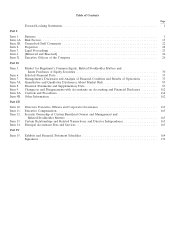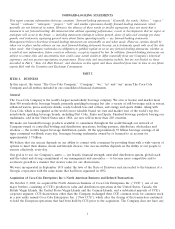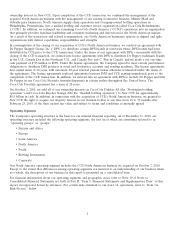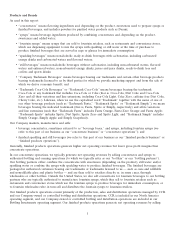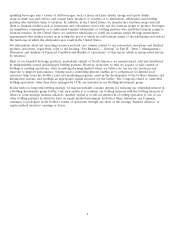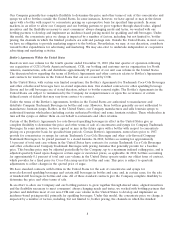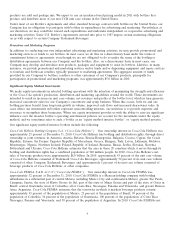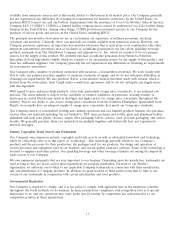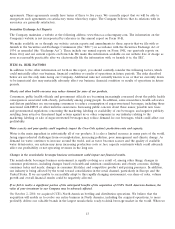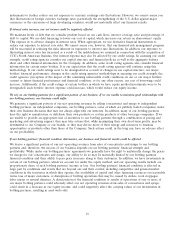Coca Cola 2010 Annual Report Download - page 11
Download and view the complete annual report
Please find page 11 of the 2010 Coca Cola annual report below. You can navigate through the pages in the report by either clicking on the pages listed below, or by using the keyword search tool below to find specific information within the annual report.products are sold and package mix. We expect to use an incidence-based pricing model in 2011 with bottlers that
produce and distribute most of our non-CCR unit case volume in the United States.
Under most of our Bottler’s Agreements and other standard beverage contracts with bottlers in the United States, our
Company has no obligation to participate with bottlers in expenditures for advertising and marketing. Nevertheless, at
our discretion, we may contribute toward such expenditures and undertake independent or cooperative advertising and
marketing activities. Some U.S. Bottler’s Agreements entered into prior to 1987 impose certain marketing obligations
on us with respect to certain Company Trademark Beverages.
Promotions and Marketing Programs
In addition to conducting our own independent advertising and marketing activities, we may provide promotional and
marketing services or funds to our bottlers. In most cases, we do this on a discretionary basis under the terms of
commitment letters or agreements, even though we are not obligated to do so under the terms of the bottling or
distribution agreements between our Company and the bottlers. Also, on a discretionary basis in most cases, our
Company may develop and introduce new products, packages and equipment to assist its bottlers. Likewise, in many
instances, we provide promotional and marketing services and/or funds and/or dispensing equipment and repair services
to fountain and bottle/can retailers, typically pursuant to marketing agreements. The aggregate amount of funds
provided by our Company to bottlers, resellers or other customers of our Company’s products, principally for
participation in promotional and marketing programs, was approximately $5.0 billion in 2010.
Significant Equity Method Investments
We make equity investments in selected bottling operations with the intention of maximizing the strength and efficiency
of the Coca-Cola system’s production, distribution and marketing capabilities around the world. These investments are
intended to result in increases in unit case volume, net revenues and profits at the bottler level, which in turn generate
increased concentrate sales for our Company’s concentrate and syrup business. When this occurs, both we and our
bottling partners benefit from long-term growth in volume, improved cash flows and increased shareowner value. In
cases where our investments in bottlers represent noncontrolling interests, our intention is to provide expertise and
resources to strengthen those businesses. When our equity investment provides us with the ability to exercise significant
influence over the investee bottler’s operating and financial policies, we account for the investment under the equity
method, and we sometimes refer to such a bottler as an ‘‘equity method investee bottler’’ or ‘‘equity method investee.’’
Our significant equity method investee bottlers include the following:
Coca-Cola Hellenic Bottling Company S.A. (‘‘Coca-Cola Hellenic’’). Our ownership interest in Coca-Cola Hellenic was
approximately 23 percent at December 31, 2010. Coca-Cola Hellenic has bottling and distribution rights, through direct
ownership or joint ventures, in Armenia, Austria, Belarus, Bosnia-Herzegovina, Bulgaria, Croatia, Cyprus, the Czech
Republic, Estonia, the Former Yugoslav Republic of Macedonia, Greece, Hungary, Italy, Latvia, Lithuania, Moldova,
Montenegro, Nigeria, Northern Ireland, Poland, Republic of Ireland, Romania, Russia, Serbia, Slovakia, Slovenia,
Switzerland and Ukraine. Coca-Cola Hellenic estimates that the area in these 28 countries which it serves through its
bottling and distribution rights has a combined population of 560 million people. In 2010, Coca-Cola Hellenic’s net
sales of beverage products were approximately $8.8 billion. In 2010, approximately 43 percent of the unit case volume
of Coca-Cola Hellenic consisted of Trademark Coca-Cola Beverages; approximately 52 percent of its unit case volume
consisted of other Company Trademark Beverages; and approximately 5 percent of its unit case volume consisted of
beverage products of Coca-Cola Hellenic or other companies.
Coca-Cola FEMSA, S.A.B. de C.V. (‘‘Coca-Cola FEMSA’’). Our ownership interest in Coca-Cola FEMSA was
approximately 32 percent at December 31, 2010. Coca-Cola FEMSA is a Mexican holding company with bottling
subsidiaries in a substantial part of central Mexico, including Mexico City and southeastern Mexico; greater S˜
ao Paulo,
Campinas, Santos, the state of Matto Grosso do Sul, part of the state of Minas Gerais and part of the state of Goias in
Brazil; central Guatemala; most of Colombia; all of Costa Rica, Nicaragua, Panama and Venezuela; and greater Buenos
Aires, Argentina. Coca-Cola FEMSA estimates that the territories in which it markets beverage products contain
approximately 45 percent of the population of Mexico, 23 percent of the population of Brazil, 99 percent of the
population of Colombia, 36 percent of the population of Guatemala, 100 percent of the populations of Costa Rica,
Nicaragua, Panama and Venezuela, and 30 percent of the population of Argentina. In 2010, Coca-Cola FEMSA’s net
9


